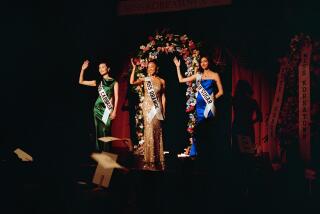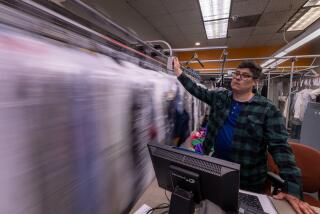Bridging old and new
- Share via
Perched behind a counter lined with candy jars and plastered with beer ads in her liquor store, Young Ok Lee has been an unlikely sentry of Koreatown for 24 years.
Up the street, there are signs of a new, hip Koreatown: A towering glass condominium selling million-dollar units. The sleek nightclub around the corner where bottle service easily runs close to $1,000. The numerous supermarkets, restaurants, bars and coffee shops constantly cropping up in an area not quite three square miles, drawing bustling, young crowds.
Lee’s store serves a different clientele. Hers is the Koreatown of working-class families, mom and pop stores, and new immigrants mostly from Latin America struggling to find their footing.
Every morning at 7, the 71-year-old opens her liquor store at 8th Street and Western Avenue to greet a stream of hard-working customers whom the Koreatown boom has largely bypassed. Children poke their heads in on their way to school, knowing she will hand them pieces of candy. Neighborhood regulars and bus drivers at the end of their route hastily grab chips or pastries in lieu of a proper lunch. In the late afternoon, a rush of busboys, cashiers and nursing assistants stops on the way home for milk or soap, or cans of cold beer that she brown-bags along with marital advice.
“No mucho drink, OK? Your wife angry.”
It’s much like two decades ago when Western Avenue went up in flames all around her, when tears filled her eyes from the smoke and the streets were strewn with broken glass. Lee’s store stayed open -- she passed out water and juice and sold everything else to neighborhood regulars at half-price. After closing, she slept curled up in the store’s aisles because of the dusk-to-dawn curfew.
Her store remained untouched -- something she can’t quite explain, except to say that the neighborhood looked out for her.
People said then that Koreatown, and the dreams riding on it, were over. Koreans were moving out in droves -- leaving Los Angeles behind for Garden Grove, for Denver, for Seoul.
For years, buildings remained scorched, storefronts stayed shuttered. A crime wave swept through after the riots, further rattling nerves.
Lee stayed. This was her home, her community; to leave was not an option. Where else would her neighborhood regulars get their wares?
No iron bars
When she first arrived in 1974, there were grassy, empty lots in the area Koreatown now occupies.
The large corporations that used to occupy high-rises along the Wilshire corridor began moving out in the early 1980s, and Korean businesses were trickling in, expanding Koreatown north from its historic center along Olympic Boulevard. Korean signage and billboards began lining the streets, demarcating the fast-growing community. Most of its inhabitants were like Lee, hard-working immigrants trying to make ends meet.
After first working as a seamstress, she ran a small Korean restaurant, then in 1988, opened up OK Liquor a block from her apartment.
There were robberies, shoplifting teenagers, customers who seemed hostile. But rather than erecting a plexiglass barrier or iron bars, she folded over and bowed. An-nyoung-ha-se-yo, gam-sa-hap-ni-da, she’d say, as you would in Korea. Hello, thank you. It caught on with the little kids, and soon, even the ones who viewed her with suspicion began reciprocating, bowing to her from halfway down the block.
The husband she immigrated with left her, and with no children, the neighborhood slowly became her family. She went from being called senora to mama. She picked up Spanish, her regulars picked up Korean. Photos of smiling neighborhood children and bills from around the world that customers gave her came to line the shelves behind the counter. People rushed over to help unload delivery trucks, and quietly took away the trash she left out front.
The 1992 riots that sparked in South L.A. quickly found their way to Koreatown. Still fresh was the memory of a Korean grocer in South L.A. who fatally shot a 15-year-old black girl in the back. Economic frustrations that fueled the riots found a ready target in about 2,200 Korean-run businesses in Koreatown, South L.A. and elsewhere, whose owners were criticized for their disconnection from surrounding communities. Store owners and even the consulate covered up Korean lettering on their signs, even as they struggled for an explanation, as they would for many years to come, why they had become objects of such resentment. Images of middle-aged Korean men holed up on rooftops with automatic rifles, spraying the streets with bullets, became iconic of the tensions that turned the city into a battleground.
A shoe store just down the street from Lee’s store was looted, a noodle shop set on fire, a jewelry store ransacked. Whole buildings burned to the ground.
Informal survey
Lee can’t pinpoint when the area started coming back. She just knows that at some point, tastes and wallets migrated from Budweiser, Coors, and Tecate to Modelos, Corona and the occasional Heineken. She still shakes her head in disbelief on a recent Friday night when someone brings up to the counter a six-pack of a fancy lager that goes for $9.
She takes an informal survey of the state of the economy when her regulars walk in at the end of the day. “ Mucho, poquito?” she asks. It’s her way of inquiring, how was business?
A nod of the chin says the restaurant was bustling, the market full of customers. A sigh or shake of the head means times are tough.
Perhaps the rebirth began after the Asian financial crisis in the late 1990s, when an influx of cash came to Koreatown from South Korean investors looking for a safe haven. Or when the second generation of Korean immigrants began taking over, with fluent English and a better idea of how to attract a diverse, moneyed crowd. Or when chic modern developments cropped up along Wilshire Boulevard beginning in the mid-2000s, changing Koreatown’s skyline and its image.
In 20 years, the percentage of Koreatown residents living below the poverty rate has fallen about 10%, and those with college diplomas now make up about a third of the neighborhood, compared to 20% in 1990. With three Metro stops and myriad bus routes, the neighborhood is the densest part of Los Angeles. Real estate agents say prices have appreciated faster than elsewhere and held up despite the bad economy. Bars, restaurants and coffee shops are open late, if not around the clock, attracting both revelers and students from across town.
Lured by its promises and opportunities, Koreatown is a diverse cross-section of Los Angeles. Nested within is a Little Bangladesh, a community of Oaxacans, as well as Salvadorans, Guatemalans and Filipinos. Occupying the site of one of the first Korean restaurants along Olympic Boulevard, still with its Korean-style awning, is a Zapotec restaurant.
“It’s not an enclave, it’s a nexus and a hub,” said Kyeyoung Park, a UCLA anthropology professor who has extensively researched Koreatown.
The new Koreatown has attracted people like Jimmy and Yume Han, young newlyweds who last year opened up a craft beer bar a few blocks north of Lee’s store.
Jimmy’s family lived in Koreatown apartments around the time of the riots when his parents were going through bankruptcy, but moved out to Hancock Park as soon as they regained their footing.
Now, he and his wife live in a renovated apartment along Wilshire Boulevard. They run Beer Belly, adorned with a mural in street-art style and gaining a following among writers, teachers and beer aficionados, many of whom live nearby and walk or bike to the bar.
There during happy hour you might find Tafarai Bayne, a 29-year-old South L.A. activist and community organizer who lives on the outskirts of Koreatown. Bayne grew up in South L.A. but has lived all over town, from Echo Park to Venice to Lincoln Heights. In Koreatown, where he moved last November, Bayne sees a model he would like to see South L.A. move toward, with its transportation, grocery stores and night life, an infrastructure that enables local living.
In 2008, Koreatown made the final round of real estate blog Curbed LA’s Neighborhood of the Year vote, beating Silver Lake and West Hollywood before narrowly losing to Culver City.
But in the shadows of the rapid development, Lee has also watched many a hard-working family being pushed out of the area as rents soared.
Her rules
Today, Lee’s store is something of an anachronism in a revitalized, gentrified Koreatown.
By the entrance to the corner store sits a coin-operated pay phone.
There is no credit card machine, but she sells to regulars on credit -- “ Manana,” she says. She refuses to carry cigars, lottery tickets or condoms. Her store, her rules.
On a recent afternoon, Danny Trujillo, a 29-year-old who lives upstairs, comes around to pick up his lunch -- pecan muffins and a can of Kerns fruit soda -- on his way to work at a market on the other side of Koreatown. Like countless times before, she waves him off and doesn’t let him pay.
She also hands him $600 in a wad of bills. He had saved up more than $700 in dollar coins and asked her to change them into bills. The rest, she’ll give him later.
“Bye umma,” he says as he rushes out, calling her mom in Korean.
A teenage girl drops in and hands her a deli sandwich from Ralphs across the street.
“Mama, can you refrigerate this so I can eat it later with my boyfriend?”
Later in the night, two young men wearing snug-fitting black pants and sky blue dress shirts walk in, with earpieces and walkie talkies and name tags that read “Yoyo” and “Coco” -- waiters at the nightclub up the block.
They grab energy drinks out of the fridge, and Coco asks Lee about how to prune the pumpkin plant that sprouted from the seeds she gave him.
Twenty minutes before closing, two patrol officers drop in, as they do every night. She shows off an invitation she received from the LAPD for her donations to the Olympic station that opened in 2009.
One of them, who has been patrolling Koreatown for 14 years, tells his partner how as a rookie, he’d hear half a dozen robbery calls from the area each night. Now, there are one or two, if any.
He still marvels that for all these years she alone has manned the open counter, with only faded newspaper clippings about the Lakers standing between her and potential miscreants.
She’s thought about retiring. But then a customer hands her a McDonald’s apple pie, or a 4-year-old boy gives her a hug in return for a Popsicle, making it impossible to leave.
At 11, she locks the doors and turns off the lights. She’ll be back just eight hours later, as she has every day for the last two decades, a steady anchor in a fast-changing neighborhood.
--
Times staff writers Sandra Poindexter and Doug Smith contributed to this report.
More to Read
Sign up for Essential California
The most important California stories and recommendations in your inbox every morning.
You may occasionally receive promotional content from the Los Angeles Times.











